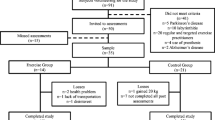Abstract
We hypothesized that short-term endurance training improves balance in older adults, if training involves movements that “stress” balance. We tested the hypothesis by looking for a dose-response relationship between movement during exercise and balance improvement. The study was a single-blinded, randomized controlled trial. Subjects were sedentary adults (N=106) aged 68–85 with at least mild deficits in balance. Exercise groups were: stationary cycle (low movement), walking (medium movement), and aerobic movement (high movement). Subjects attended supervised exercise classes three times a week for three months, followed by self-directed exercise of any type for three months. The primary test of the hypothesis compared changes in balance after three months of supervised exercise. One balance measure (distance walked on a six-meter narrow balance beam) improved in the hypothesized dose-response manner (cycle, 3% improvement; walking, 7% improvement; aerobic movement, 18% improvement: p<0.02, test of trend). Other balance measures did not improve with exercise. Only walking exercise improved gait speed (by 5%, p<0.02) and SF-36 role-physical score (by 24%, p<0.05). VO2max improved with walking (18%, p<0.004) and aerobic movement (10%, p<0.01), but improved less with cycling (8%, p>0.1). Leg strength improved significantly in all exercise groups. The study hypothesis was supported only for one balance measure. Only walking improved at least one measure of all major outcomes (endurance, strength, gait, balance, health status), suggesting that walking is most useful for fall prevention. Cycle exercise appeared least useful.
Similar content being viewed by others
References
Tinetti M.E., Speechley M., Ginter S.F.: Risk factors for falls among elderly persons living in the community. N. Engl. J. Med. 319: 1701–1707, 1988.
Wolfson L., Whipple R., Derby C., Judge J., King M., Amerman P., Schmidt J., Smyers D.: Balance and strength training in older adults: intervention gains and Tai Chi maintenance. J. Am. Geriatr. Soc. 44: 498–506, 1996.
Wolf S.L., Barnhart H.X., Kutner N.G., McNeely E., Coogler C., Xu T.: Reducing frailty and falls in older persons: an in-vestigation of Tai Chi and computerized balance training. J. Am. Geriatr. Soc. 44: 489–497, 1996.
Tinetti M.E., Baker D.I., McAvay G., Claus E.B., Garrett P., Gottschalk M., Koch M.L., Trainor K., Horwitz R.I.: A multifactorial intervention to reduce the risk of falling among elderly people living in the community. N. Engl. J. Med. 331: 821–827, 1994.
Hu M.H., Woollacott M.H.: Multisensory training of standing balance in older adults: I. Postural stability and one-leg stance balance. J. Gerontol. 49: M52–M61, 1994.
Brown M., Holloszy J.O.: Effects of a low intensity exercise program on selected physical performance characteristics of 60- to 70-year olds. Aging Clin. Exp. Res. 3: 129–139, 1991.
Lichtenstein M.J., Shields S.L., Shiavi R.G., Burger C.: Exercise and balance in aged women: a pilot controlled clinical trial. Arch. Phys. Med. Rehabil. 70: 138–143, 1989.
Crilly R.G., Willems D.A., Trenholm K.J., Hayes K.C., De-laquerriere-Richardson L.F.O.: Effect of exercise on postural sway in the elderly. Gerontology 35: 137–143, 1989.
Clark B.A., Wade M.G., Massey B.H., VanDyke R.: Response of institutionalized geriatric mental patients to a twelve-week program of regular physical activity. J. Gerontol. 30: 565–573, 1975.
Province M.A., Hadley E.C., Hornbrook M.C., Lipsitz L.A., Miller J.P., Mulrow C.D., Ory M.G., Sattin R.W., Tinetti M.E., Wolf S.L.: The effects of exercise on falls in elderly patients. A preplanned meta-analysis of the FICSIT trials. JAMA 273: 1341–1347, 1995.
Pate R.R., Pratt M., Blair S.N., Haskell W.L., Macera C.A., Bouchard C., Buchner D.M., Ettinger W., Heath G.W., King A.C., Kriska A., Leon A.S., Marcus B.M., Morris J., Paffen-barger R.S., Patrick K., Pollock M.L., Rippe J.M., Sallis J., Wilmore J.H.: Physical activity and public health. A recommendation from the Centers of Disease Control and Prevention and the American College of Sports Medicine. JAMA 273: 402–407, 1995.
Ory M.G., Schechtman K.B., Miller J.P., Hadley E.C., Fiatarone M.A., Province M.A., Arfken C.L., Morgan D., Weiss S., Kaplan M., and The FICSIT Group: Frailty and injuries in later life: the FICSIT trials. J. Am. Geriatr. Soc. 41: 283–296, 1993.
Buchner D.M., Cress M.E., Wagner E.H., de Lateur B.E., Price R., Abrass I.F.: The Seattle FICSIT study: the effect of exercise on gait and balance in older adults. J. Am. Geriatr. Soc. 41: 321–325, 1993.
Buchner D.M., Larson E.B., Wagner E.H., Koepsell T.D., de Lateur B.J.: Evidence for a non-linear relationship between leg strength and gait speed. Age Ageing 25: 386–391, 1996.
Buchner D.M., Hornbrook M.C., Kutner N.B., Tinetti M.E., Ory M., Mulrow C.O., Schechtman K.B., Gerety M.B., Fiatarone M.A., Wolf S.L., Rossiter J., Arfken C., Kanten D., Lipsitz L.A., Sattin R., De Nino L.A., and the FICSIT Group: Development of the common database for the FICSIT trials. J. Am. Geriatr. Soc. 41: 297–308, 1993.
Bergner M., Bobbitt R.A., Carter W.B., Gilson B.S.: The Sickness Impact Profile: Development and final revision of a health status measure. Med. Care 19: 787–805, 1981.
Ware J.E. Jr., Sherbourne C.D.: The MOS 36-item short-form health survey (SF-36): conceptual framework and item selection. Med. Care 30: 473–483, 1992.
Lawton M.P., Brody E.M.: Assessment of older people: self-maintaining and instrumental activities of daily living. Gerontologist 9: 179–186, 1969.
LaCroix A.Z., Leveille S.G., Hecht J.A., Grothaus L.C., Wagner E.H.: Does walking decrease the risk of cardiovascular disease hospitalizations and death in older adults? J. Am. Geriatr. Soc. 44: 113–120, 1996.
Author information
Authors and Affiliations
Rights and permissions
About this article
Cite this article
Buchner, D.M., Cress, M.E., de Lateur, B.J. et al. A comparison of the effects of three types of endurance training on balance and other fall risk factors in older adults. Aging Clin Exp Res 9, 112–119 (1997). https://doi.org/10.1007/BF03340136
Received:
Accepted:
Published:
Issue Date:
DOI: https://doi.org/10.1007/BF03340136




